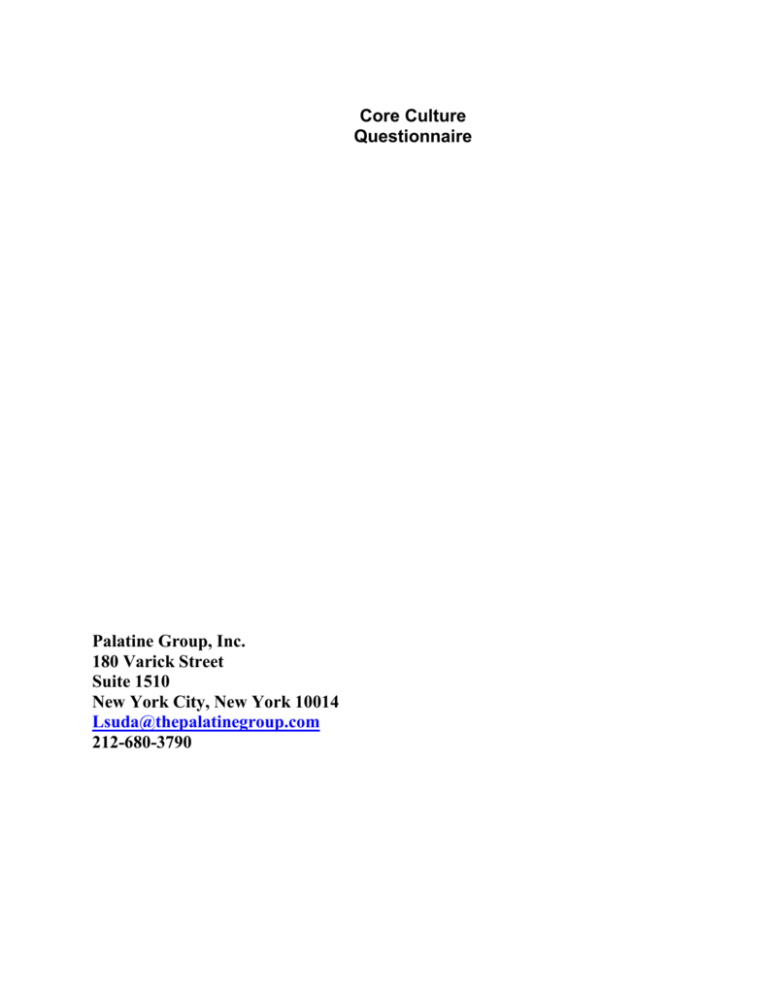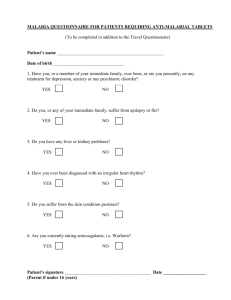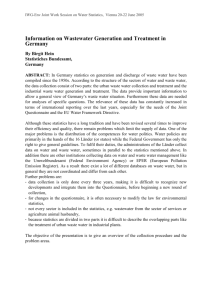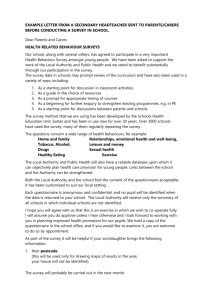
Core Culture
Questionnaire
Palatine Group, Inc.
180 Varick Street
Suite 1510
New York City, New York 10014
Lsuda@thepalatinegroup.com
212-680-3790
CORE CULTURE Questionnaire
This questionnaire is designed to help you identify the core culture that exists within
your organization quickly and in a useful way. Complete and score the questionnaire.
The questionnaire is a tool to make the concepts of this core culture personal and
concrete. The discovery and understanding of your core culture existing within your
organization allows you to work more productively. At a minimum, the questionnaire adds the
dimension of your personal experience as a continuing reference point.
This questionnaire is not a scientifically validated instrument but a helpful beginning and
guide as you discuss and gain more clarity about your core culture. The items in the
questionnaire are derived directly from the concepts of the four core cultures.
You may wish to ask others in your organization to complete copies of this
questionnaire. The results would serve as a comparative base. On items where your
colleagues differ, discuss the nature of these differences. This should help clarify what kind of
core culture exists within your organization. The way your colleagues see the behavior of your
organization may cause you to change your response to some items in the questionnaire; it
could of course work the other way around.
Scoring
Assuming that your organization has been in existence for at least a year and is
functioning in a fairly effective manner, you should score at least 50 percent or greater of the
items on one of the four core cultures. If this does not happen, it may be not only advised but
necessary to ask others to fill out the questionnaire independently in order to identify your
organization’s core culture. It is unlikely that you will have more than two.
Another approach is to read the book: “The Reenergineering Alternative,” by William
Schneider, on the two core cultures that emerge from your score and then decide which of the
two is actually present within your organization.
CORE CULTURE QUESTIONNAIRE
Instructions
This questionnaire is designed to help you determine the core culture that exists in your own
organization. As you work through the questions, keep the following in mind:
“Core culture” is defined as: How we do things in order to succeed.
For each question ask yourself: “When I boil it down and get to the heart of the matter,
which of the four possible answers most accurately describes my actual experience in
my organization?” Your organization may have a little of each of the four possible
answers, but you need to determine which is the truest for your organization. Your
actual experience in the organization is very important, so concentrate on how things
are, not only how you believe they ought to be.
Be objective. Each core culture has its own mix of strengths and weaknesses, and you
are trying to determine only the kind that exists in your organization.
Focus on your whole organization. These questions are not about your department,
your group, your division, or your unit but about the organization as a whole.
Answer every question, and select only one answer for each. When in doubt, go with the
first response you had when you read the question.
V.041604 © Copyright 1994-2011, Corporate Development Group, Inc.
All Rights Reserved: Used with Permission
2
Questionnaire
1. When all is said and done, the way we accomplish success in the organization is to:
_________a. Get and keep control.
_________b. Put a collection of people together, build them into a team, and charge them with
fully utilizing one another’s resources.
_________c. Create an organization that has the highest possible level of competence and
capitalize on that competence.
_________d. Provide the conditions whereby the people within the organization can develop and
make valuable accomplishments.
2. What do we pay attention to primarily in our organization and how do we decide about things?
_________a. We pay attention to what might be and we decide by relying on objective and
detached analysis.
_________b. We pay attention to what is and we decide by relying on what evolves from within
the hearts and minds of our people.
_________c. We pay attention to what might be and we decide by relying on what evolves from
within the hearts and minds of our people.
_________d. We pay attention to what is and we decide by relying on objective and detached
analysis.
3. The people with the most power and influence in the organization:
_________a. Are charismatic, can inspire others, and are good at motivating others to develop their
potential.
_________b. Have the title and position that gives them the right and the authority to exercise
power and influence.
_________c. Are both contributors and team players, who are an essential part of the team. People
like working with them.
_________d. Are experts or specialists, who have the most knowledge about something important.
4. In our organization, “success” means:
_________a. Synergy. By teaming up with one another and our customers, we accomplish what we
are after.
_________b. Growth. Success means helping others more fully realize their potential.
_________c. Dominance. Success means having more control than anyone else. Complete success
would be for the organization to be the only game in town.
_________d. Superiority. Success means that the organization is the best, offering superior value.
The organization is “state of the art” in all that it does.
V.041604 © Copyright 1994-2011, Corporate Development Group, Inc.
All Rights Reserved: Used with Permission
3
5. In our organization, leadership means:
_________a. Authority. Leaders are regulators and call the shots. They are commanding, firm, and
definitive. What they say goes.
_________b. Setting standards and working hard to get people to achieve more. Leaders are intense
taskmasters, who always challenge workers to do better.
_________c. Being a catalyst. Leaders cultivate people. They create conditions in which people are
inspired to fulfill their own and others’ potential. At the same time, leaders build
commitment to the organization.
_________d. Building a team that will work well together. Leaders are coaches. They behave as
first-among-equals. They strive to represent the people in the organization.
6. When we worry about something in the organization, it is usually about:
_________a. Losing. We worry most about being also-rans or having our reputation harmed
because we couldn’t deliver as well as, or better than, our competitors.
_________b. Stagnation. We worry most about failing to progress, simply existing from day to
or even going backwards.
_________c. Vulnerability. We worry most about being in a position where others have more
power or market share than we do.
_________d. Lack of unity. We worry most about the team being broken up or alienating our
customers. We worry about a lack of trust among ourselves.
7. Our organization’s overall management style is best described as:
_________a. Enabling. Empowering. Commitment oriented.
_________b. Challenging. Goal oriented. Very rational and analytical.
_________c. Democratic. Highly relational. Highly participative.
_________d. Prescriptive. Methodical. Policy and procedure oriented.
8. The essential role of the individual employee in our organization is to:
_________a. Collaborate. To be a team player.
_________b. Be an expert. To be the best in your specialty or area of technical expertise.
_________c. Perform according to policy and procedure. To meet the requirements of the job as
outlined.
_________d. Be all you can be. To change, develop, and grow. To be committed to the
organization and its purposes.
9. What counts most in the organization is:
_________a. Winning. Being recognized as the best competitor around.
_________b. Not losing. Keeping what we’ve got.
_________c. Evolving. Realizing greater potential. Fulfilling commitments.
_________d. Accomplishing it together. Being able to say “we did it together.”
V.041604 © Copyright 1994-2011, Corporate Development Group, Inc.
All Rights Reserved: Used with Permission
4
10. Which of the following best describes how you feel about working in your organization:
_________a. This is a caring and “spirited” place. I feel supported.
_________b. People are able to count on one another.
_________c. Things are no nonsense and restrained.
_________d. Things are rather intense. I feel like I have to be on my toes all the time.
11. What counts most in the organization is:
_________a. Security.
_________b. Community.
_________c. Merit.
_________d. Fulfillment.
12. Which of the following best describes the primary way decisions are made in the organization?
_________a. We pay close attention to our concepts and standards. We emphasize the fit between
our theoretical goals and the extent to which we achieve them. Our decision-making
process centers on how systematically our conceptual goals are achieved.
_________b We pay close attention to our values. We emphasize the fit between our values and
how close we are to realizing them. Our decision-making process centers on the
congruence between our values or purposes and what we have put into practice.
_________c. We emphasize what the organization needs. Our decision-making process centers on
the objectives of the organization and on what we need from each function within
the organization.
_________d. We emphasize tapping into the experiences of one another. Our decision-making
process centers on fully using our collective experiences and pushing for a consensus.
13. Overall, life inside our organization is:
_________a. Spontaneous, interactive, and free and easy.
_________b. Intellectually competitive, rigorous, and intense.
_________c. Objective, orderly, and serious.
_________d. Subjective, dedicated, and purposeful.
14. In general, our attitude toward mistake is:
_________a. We tend to minimize the impact of mistakes and do not worry much about them.
People who make mistakes should be given another chance.
_________b. Mistakes are inevitable, but we manage by picking up the pieces and making the
necessary corrections before they grow into bigger problems.
_________c. Mistakes are nearly taboo. We don’t like them. A person who make mistakes is
looked down upon.
_________d. We pay attention to the kind of mistake. If the mistake can be quickly fixed , we go
ahead and fix it. If the mistake causes a function to get in trouble or could cause the
organization to become vulnerable, we marshal all our resources to fix it as quickly as
possible. Mistakes that affect the organization as a whole could get someone in
trouble.
V.041604 © Copyright 1994-2011, Corporate Development Group, Inc.
All Rights Reserved: Used with Permission
5
15. Concerning control, which of the following is most emphasized?
__________a. Concepts and ideas. We control everything that is critical toward achieving or
preserving our superiority in the marketplace.
__________b. Everything critical to keeping us working together in the organization and retaining
close ties with our customers.
__________c. Just about everything. Getting and keeping control is central to what the
organization is and does.
__________d. As little as possible. We are put off by the notion of control. We prefer to leave
things up to the commitment and good will of our people.
16. The essential nature of work in the organization emphasizes:
__________a. Functionalists. Individuals stay within their function. Specialties are subordinate to
the service of functions.
__________b. Specialists. Individuals stay in their technical or other specialty. Functions are
channeled into the service of specialties.
__________c. Generalists. Individuals move in and out of numerous functions and specialties.
__________d. All of the above. Individuals do all three.
17. The people who primarily get promoted in the organization are:
__________a. Generalists. They must also be capable people who are easy to work with.
__________b. Those who have performed consistently well in their function for many years
and have demonstrated that they can seize authority and get things done.
__________c. Those who know the most about their area of expertise and have demonstrated
their competence.
__________d. People who can handle responsibility and who want it. We don’t use the word
“promotion.”
18. The compensations system in the organization is most similar to which of the following?
__________a. We emphasize fair and equitable pay for all. We also emphasize the long-term
perspective. We plow a lot of money back into the organization to ensure
continued growth and success, so personal financial compensation tends to be
secondary to other more important matters.
__________b. Our compensation system is highly individual and incentive-oriented. Uniquely
capable people who are recognized experts can make a lot of money.
__________c. Our compensation system is highly structured. The larger your role and function in
the organization, the more money you make.
__________d. Our compensation is tied primarily to team effort. If the whole organization does
well, we all share in the wealth. If the whole organization does poorly, we all
sacrifice
V.041604 © Copyright 1994-2011, Corporate Development Group, Inc.
All Rights Reserved: Used with Permission
6
19. Which of the following best describes our organization’s primary approach in dealing with
customers or constituents?
__________a. Partnership. We team up with our customers or constituents. We want to be able
to say “We did it together.”
__________b. We emphasize uplifting and enriching our customers or constituents. We
concentrate on realizing the possibilities and potential of our customers or
or constituents more fully.
__________c. We emphasize gaining the greatest market share that we can get. We would like to
be the only game in town for our customers or constituents.
__________d. We emphasize offering superior value to our customers or constituents. We try to
provide state-of-the-art goods or services to our customers or constituents.
20. Which phrase best describes our organization?
__________a. “We believe in what we are doing, we make a commitment, and we realize
unlimited potential.”
__________b. “We are the best at what we do.”
__________c. “We are the biggest at what we do.”
__________d. “United we stand, divided we fall.”
Directions for Scoring the Questionnaire
Record your answer to each question (a, b, c, or d) on the Scoring Table by writing an “X”
across the letter chosen at the proper question number. Do this for every question.
When finished, add up the total number of X’s recorder under each roman numeral at
the top of the Scoring Table. Roman numeral I relates to the control culture, roman
numeral II to the collaboration culture, roman numeral III to the competence culture, and
roman numeral IV to the cultivation culture. The roman numeral with the majority of X’s is
your organization’s core culture. A majority is 50 percent or greater, or 10 out of 20 items or
greater. If your scores do not reflect a clear majority in one core culture, reread the first part
of this handout.
NOTE
The author created a more extended version of this questionnaire, which is intended for use in organizational
analysis and development efforts. This extended version will not only address the question of which core
culture exists within any one organization, but will also identify the extent to which various critical
organizational sub factors (i.e., selection of new personnel, approach with customers/constituents,
management style, and so on) are or are not congruent with one’s organizational core culture. If you are
interested in accurately measuring your organizational culture, CDG has developed a statistically valid assessment for
accomplishing this.”
V.041604 © Copyright 1994-2011, Corporate Development Group, Inc.
All Rights Reserved: Used with Permission
7
Question
A
B
C
D
D
B
A
C
B
C
D
A
C
A
D
B
A
D
B
C
C
D
A
B
D
C
B
A
C
A
B
D
B
D
A
C
C
B
D
A
A
B
C
D
C
D
A
B
C
A
B
D
D
B
C
A
C
B
A
D
A
C
B
D
B
A
C
D
C
D
B
A
C
A
D
B
C
D
B
A
Control
Collaboration
Competence
Cultivation
1
2
3
4
5
6
7
8
9
10
11
12
13
14
15
16
17
18
19
20
Total
V.041604 © Copyright 1994-2011, Corporate Development Group, Inc.
All Rights Reserved: Used with Permission
8
NOTES:
V.041604 © Copyright 1994-2011, Corporate Development Group, Inc.
All Rights Reserved: Used with Permission
9









